Qualitative Study of Patients’ Attitudes toward HIV Testing
VerifiedAdded on 2023/01/20
|8
|2264
|52
AI Summary
This qualitative study explores patients' attitudes toward HIV testing in the USA. Findings show positive responses and willingness to be tested. The study utilized a case study research design and was conducted in New York City. The participants were chosen through convenient sampling, and data collection and analysis techniques were appropriate. The results suggest the need for free and accessible HIV testing services, as well as counseling and education for patients. The study has implications for clinical practice and the care of HIV/AIDS patients.
Contribute Materials
Your contribution can guide someone’s learning journey. Share your
documents today.
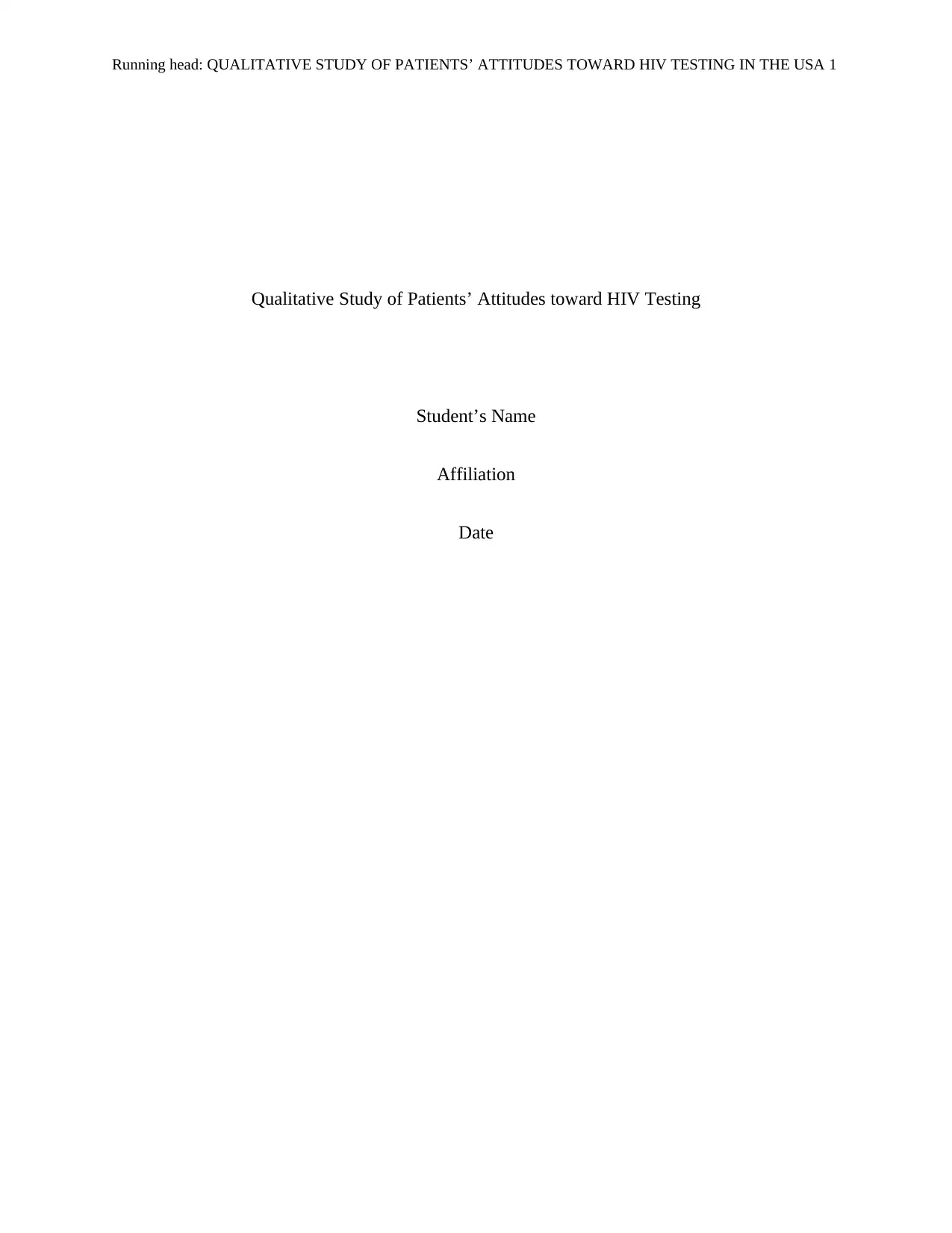
Running head: QUALITATIVE STUDY OF PATIENTS’ ATTITUDES TOWARD HIV TESTING IN THE USA 1
Qualitative Study of Patients’ Attitudes toward HIV Testing
Student’s Name
Affiliation
Date
Qualitative Study of Patients’ Attitudes toward HIV Testing
Student’s Name
Affiliation
Date
Secure Best Marks with AI Grader
Need help grading? Try our AI Grader for instant feedback on your assignments.
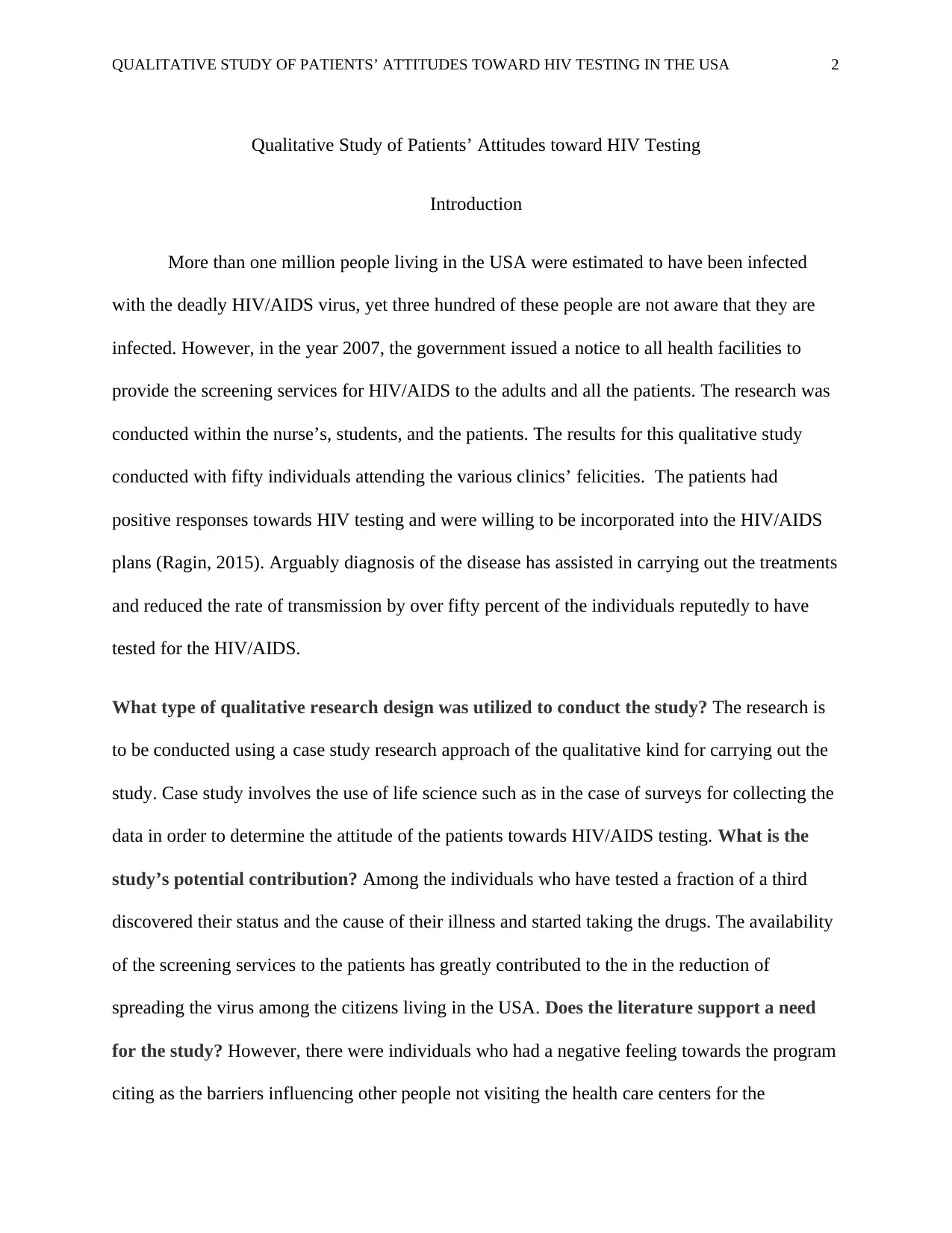
QUALITATIVE STUDY OF PATIENTS’ ATTITUDES TOWARD HIV TESTING IN THE USA 2
Qualitative Study of Patients’ Attitudes toward HIV Testing
Introduction
More than one million people living in the USA were estimated to have been infected
with the deadly HIV/AIDS virus, yet three hundred of these people are not aware that they are
infected. However, in the year 2007, the government issued a notice to all health facilities to
provide the screening services for HIV/AIDS to the adults and all the patients. The research was
conducted within the nurse’s, students, and the patients. The results for this qualitative study
conducted with fifty individuals attending the various clinics’ felicities. The patients had
positive responses towards HIV testing and were willing to be incorporated into the HIV/AIDS
plans (Ragin, 2015). Arguably diagnosis of the disease has assisted in carrying out the treatments
and reduced the rate of transmission by over fifty percent of the individuals reputedly to have
tested for the HIV/AIDS.
What type of qualitative research design was utilized to conduct the study? The research is
to be conducted using a case study research approach of the qualitative kind for carrying out the
study. Case study involves the use of life science such as in the case of surveys for collecting the
data in order to determine the attitude of the patients towards HIV/AIDS testing. What is the
study’s potential contribution? Among the individuals who have tested a fraction of a third
discovered their status and the cause of their illness and started taking the drugs. The availability
of the screening services to the patients has greatly contributed to the in the reduction of
spreading the virus among the citizens living in the USA. Does the literature support a need
for the study? However, there were individuals who had a negative feeling towards the program
citing as the barriers influencing other people not visiting the health care centers for the
Qualitative Study of Patients’ Attitudes toward HIV Testing
Introduction
More than one million people living in the USA were estimated to have been infected
with the deadly HIV/AIDS virus, yet three hundred of these people are not aware that they are
infected. However, in the year 2007, the government issued a notice to all health facilities to
provide the screening services for HIV/AIDS to the adults and all the patients. The research was
conducted within the nurse’s, students, and the patients. The results for this qualitative study
conducted with fifty individuals attending the various clinics’ felicities. The patients had
positive responses towards HIV testing and were willing to be incorporated into the HIV/AIDS
plans (Ragin, 2015). Arguably diagnosis of the disease has assisted in carrying out the treatments
and reduced the rate of transmission by over fifty percent of the individuals reputedly to have
tested for the HIV/AIDS.
What type of qualitative research design was utilized to conduct the study? The research is
to be conducted using a case study research approach of the qualitative kind for carrying out the
study. Case study involves the use of life science such as in the case of surveys for collecting the
data in order to determine the attitude of the patients towards HIV/AIDS testing. What is the
study’s potential contribution? Among the individuals who have tested a fraction of a third
discovered their status and the cause of their illness and started taking the drugs. The availability
of the screening services to the patients has greatly contributed to the in the reduction of
spreading the virus among the citizens living in the USA. Does the literature support a need
for the study? However, there were individuals who had a negative feeling towards the program
citing as the barriers influencing other people not visiting the health care centers for the
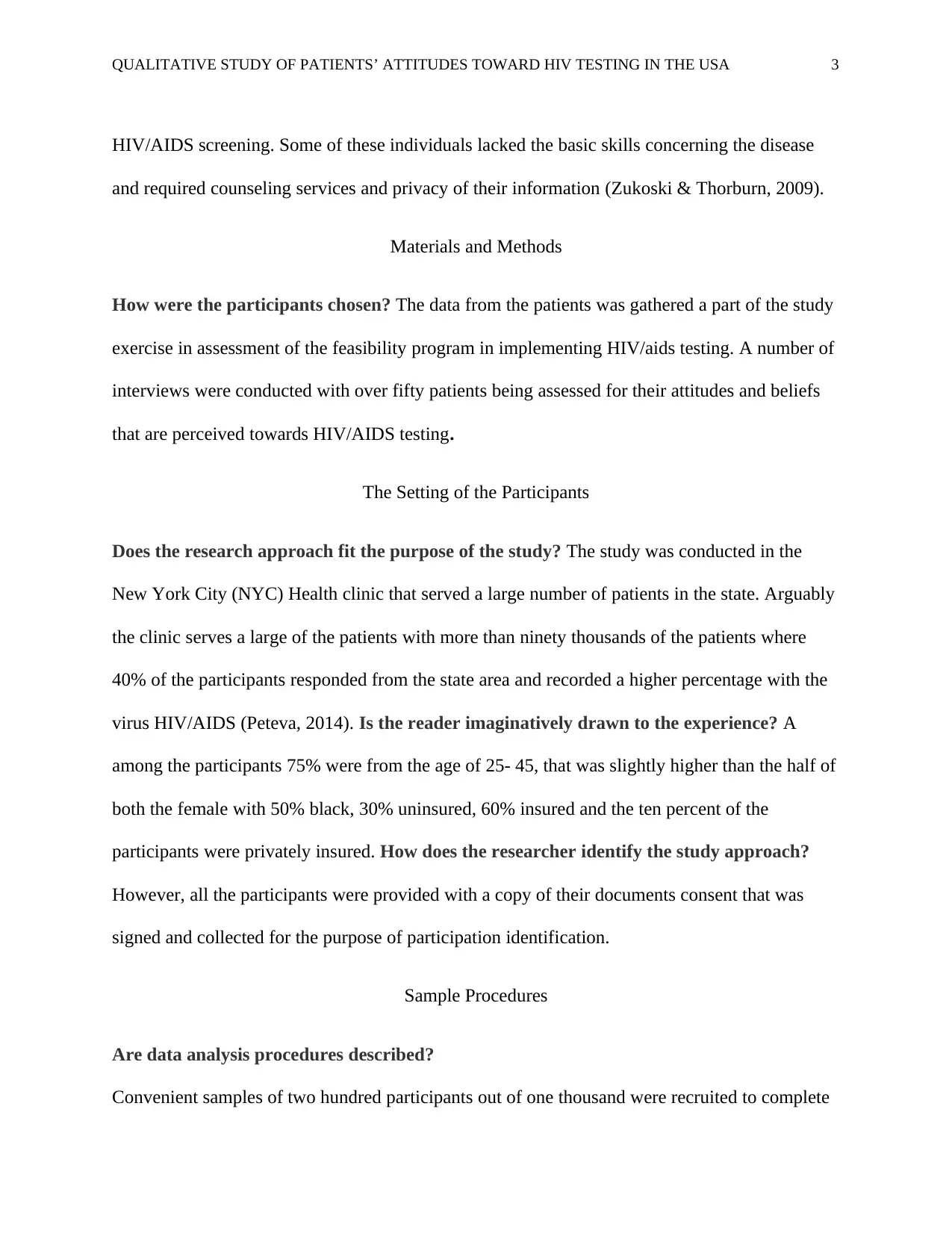
QUALITATIVE STUDY OF PATIENTS’ ATTITUDES TOWARD HIV TESTING IN THE USA 3
HIV/AIDS screening. Some of these individuals lacked the basic skills concerning the disease
and required counseling services and privacy of their information (Zukoski & Thorburn, 2009).
Materials and Methods
How were the participants chosen? The data from the patients was gathered a part of the study
exercise in assessment of the feasibility program in implementing HIV/aids testing. A number of
interviews were conducted with over fifty patients being assessed for their attitudes and beliefs
that are perceived towards HIV/AIDS testing.
The Setting of the Participants
Does the research approach fit the purpose of the study? The study was conducted in the
New York City (NYC) Health clinic that served a large number of patients in the state. Arguably
the clinic serves a large of the patients with more than ninety thousands of the patients where
40% of the participants responded from the state area and recorded a higher percentage with the
virus HIV/AIDS (Peteva, 2014). Is the reader imaginatively drawn to the experience? A
among the participants 75% were from the age of 25- 45, that was slightly higher than the half of
both the female with 50% black, 30% uninsured, 60% insured and the ten percent of the
participants were privately insured. How does the researcher identify the study approach?
However, all the participants were provided with a copy of their documents consent that was
signed and collected for the purpose of participation identification.
Sample Procedures
Are data analysis procedures described?
Convenient samples of two hundred participants out of one thousand were recruited to complete
HIV/AIDS screening. Some of these individuals lacked the basic skills concerning the disease
and required counseling services and privacy of their information (Zukoski & Thorburn, 2009).
Materials and Methods
How were the participants chosen? The data from the patients was gathered a part of the study
exercise in assessment of the feasibility program in implementing HIV/aids testing. A number of
interviews were conducted with over fifty patients being assessed for their attitudes and beliefs
that are perceived towards HIV/AIDS testing.
The Setting of the Participants
Does the research approach fit the purpose of the study? The study was conducted in the
New York City (NYC) Health clinic that served a large number of patients in the state. Arguably
the clinic serves a large of the patients with more than ninety thousands of the patients where
40% of the participants responded from the state area and recorded a higher percentage with the
virus HIV/AIDS (Peteva, 2014). Is the reader imaginatively drawn to the experience? A
among the participants 75% were from the age of 25- 45, that was slightly higher than the half of
both the female with 50% black, 30% uninsured, 60% insured and the ten percent of the
participants were privately insured. How does the researcher identify the study approach?
However, all the participants were provided with a copy of their documents consent that was
signed and collected for the purpose of participation identification.
Sample Procedures
Are data analysis procedures described?
Convenient samples of two hundred participants out of one thousand were recruited to complete
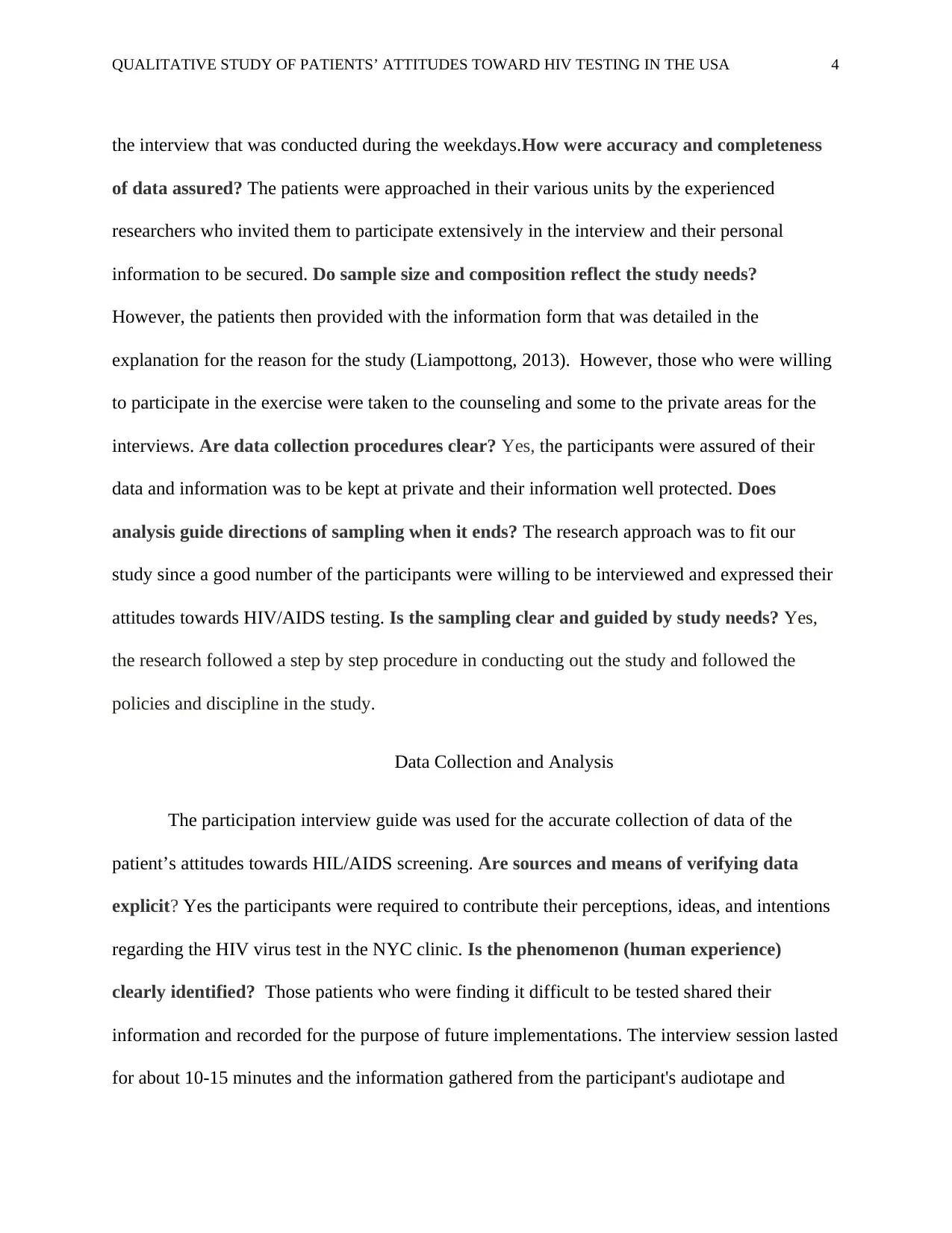
QUALITATIVE STUDY OF PATIENTS’ ATTITUDES TOWARD HIV TESTING IN THE USA 4
the interview that was conducted during the weekdays.How were accuracy and completeness
of data assured? The patients were approached in their various units by the experienced
researchers who invited them to participate extensively in the interview and their personal
information to be secured. Do sample size and composition reflect the study needs?
However, the patients then provided with the information form that was detailed in the
explanation for the reason for the study (Liampottong, 2013). However, those who were willing
to participate in the exercise were taken to the counseling and some to the private areas for the
interviews. Are data collection procedures clear? Yes, the participants were assured of their
data and information was to be kept at private and their information well protected. Does
analysis guide directions of sampling when it ends? The research approach was to fit our
study since a good number of the participants were willing to be interviewed and expressed their
attitudes towards HIV/AIDS testing. Is the sampling clear and guided by study needs? Yes,
the research followed a step by step procedure in conducting out the study and followed the
policies and discipline in the study.
Data Collection and Analysis
The participation interview guide was used for the accurate collection of data of the
patient’s attitudes towards HIL/AIDS screening. Are sources and means of verifying data
explicit? Yes the participants were required to contribute their perceptions, ideas, and intentions
regarding the HIV virus test in the NYC clinic. Is the phenomenon (human experience)
clearly identified? Those patients who were finding it difficult to be tested shared their
information and recorded for the purpose of future implementations. The interview session lasted
for about 10-15 minutes and the information gathered from the participant's audiotape and
the interview that was conducted during the weekdays.How were accuracy and completeness
of data assured? The patients were approached in their various units by the experienced
researchers who invited them to participate extensively in the interview and their personal
information to be secured. Do sample size and composition reflect the study needs?
However, the patients then provided with the information form that was detailed in the
explanation for the reason for the study (Liampottong, 2013). However, those who were willing
to participate in the exercise were taken to the counseling and some to the private areas for the
interviews. Are data collection procedures clear? Yes, the participants were assured of their
data and information was to be kept at private and their information well protected. Does
analysis guide directions of sampling when it ends? The research approach was to fit our
study since a good number of the participants were willing to be interviewed and expressed their
attitudes towards HIV/AIDS testing. Is the sampling clear and guided by study needs? Yes,
the research followed a step by step procedure in conducting out the study and followed the
policies and discipline in the study.
Data Collection and Analysis
The participation interview guide was used for the accurate collection of data of the
patient’s attitudes towards HIL/AIDS screening. Are sources and means of verifying data
explicit? Yes the participants were required to contribute their perceptions, ideas, and intentions
regarding the HIV virus test in the NYC clinic. Is the phenomenon (human experience)
clearly identified? Those patients who were finding it difficult to be tested shared their
information and recorded for the purpose of future implementations. The interview session lasted
for about 10-15 minutes and the information gathered from the participant's audiotape and
Secure Best Marks with AI Grader
Need help grading? Try our AI Grader for instant feedback on your assignments.
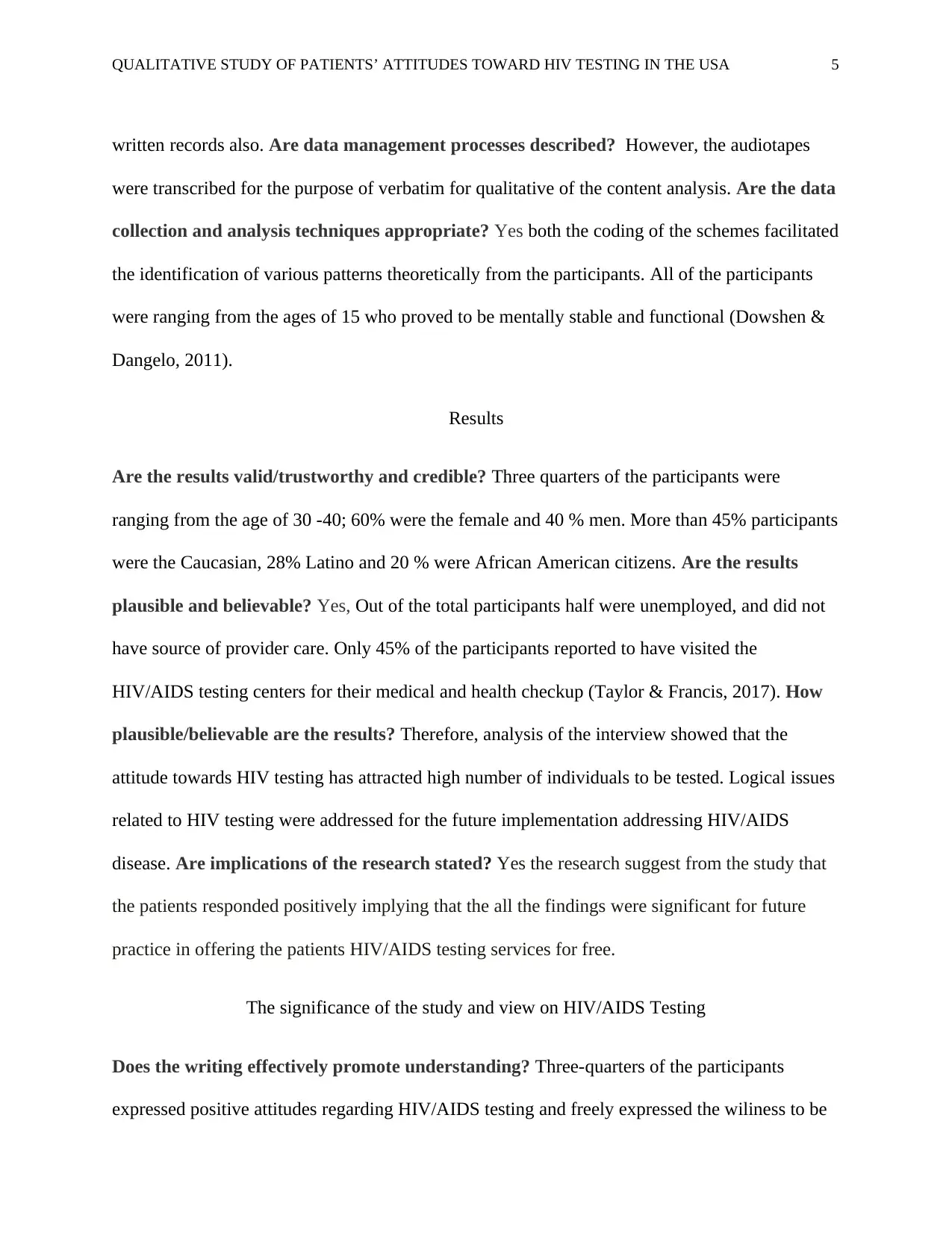
QUALITATIVE STUDY OF PATIENTS’ ATTITUDES TOWARD HIV TESTING IN THE USA 5
written records also. Are data management processes described? However, the audiotapes
were transcribed for the purpose of verbatim for qualitative of the content analysis. Are the data
collection and analysis techniques appropriate? Yes both the coding of the schemes facilitated
the identification of various patterns theoretically from the participants. All of the participants
were ranging from the ages of 15 who proved to be mentally stable and functional (Dowshen &
Dangelo, 2011).
Results
Are the results valid/trustworthy and credible? Three quarters of the participants were
ranging from the age of 30 -40; 60% were the female and 40 % men. More than 45% participants
were the Caucasian, 28% Latino and 20 % were African American citizens. Are the results
plausible and believable? Yes, Out of the total participants half were unemployed, and did not
have source of provider care. Only 45% of the participants reported to have visited the
HIV/AIDS testing centers for their medical and health checkup (Taylor & Francis, 2017). How
plausible/believable are the results? Therefore, analysis of the interview showed that the
attitude towards HIV testing has attracted high number of individuals to be tested. Logical issues
related to HIV testing were addressed for the future implementation addressing HIV/AIDS
disease. Are implications of the research stated? Yes the research suggest from the study that
the patients responded positively implying that the all the findings were significant for future
practice in offering the patients HIV/AIDS testing services for free.
The significance of the study and view on HIV/AIDS Testing
Does the writing effectively promote understanding? Three-quarters of the participants
expressed positive attitudes regarding HIV/AIDS testing and freely expressed the wiliness to be
written records also. Are data management processes described? However, the audiotapes
were transcribed for the purpose of verbatim for qualitative of the content analysis. Are the data
collection and analysis techniques appropriate? Yes both the coding of the schemes facilitated
the identification of various patterns theoretically from the participants. All of the participants
were ranging from the ages of 15 who proved to be mentally stable and functional (Dowshen &
Dangelo, 2011).
Results
Are the results valid/trustworthy and credible? Three quarters of the participants were
ranging from the age of 30 -40; 60% were the female and 40 % men. More than 45% participants
were the Caucasian, 28% Latino and 20 % were African American citizens. Are the results
plausible and believable? Yes, Out of the total participants half were unemployed, and did not
have source of provider care. Only 45% of the participants reported to have visited the
HIV/AIDS testing centers for their medical and health checkup (Taylor & Francis, 2017). How
plausible/believable are the results? Therefore, analysis of the interview showed that the
attitude towards HIV testing has attracted high number of individuals to be tested. Logical issues
related to HIV testing were addressed for the future implementation addressing HIV/AIDS
disease. Are implications of the research stated? Yes the research suggest from the study that
the patients responded positively implying that the all the findings were significant for future
practice in offering the patients HIV/AIDS testing services for free.
The significance of the study and view on HIV/AIDS Testing
Does the writing effectively promote understanding? Three-quarters of the participants
expressed positive attitudes regarding HIV/AIDS testing and freely expressed the wiliness to be
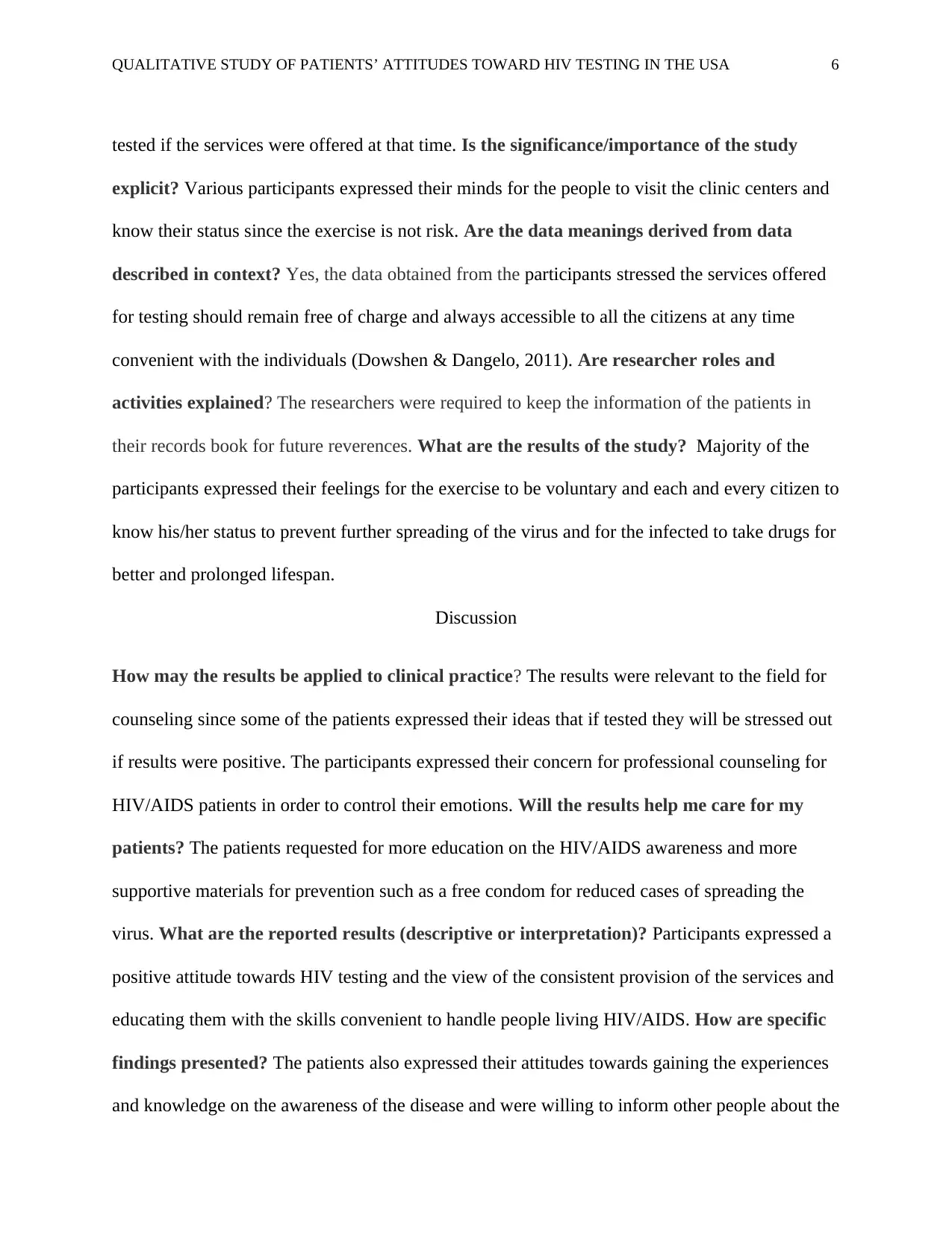
QUALITATIVE STUDY OF PATIENTS’ ATTITUDES TOWARD HIV TESTING IN THE USA 6
tested if the services were offered at that time. Is the significance/importance of the study
explicit? Various participants expressed their minds for the people to visit the clinic centers and
know their status since the exercise is not risk. Are the data meanings derived from data
described in context? Yes, the data obtained from the participants stressed the services offered
for testing should remain free of charge and always accessible to all the citizens at any time
convenient with the individuals (Dowshen & Dangelo, 2011). Are researcher roles and
activities explained? The researchers were required to keep the information of the patients in
their records book for future reverences. What are the results of the study? Majority of the
participants expressed their feelings for the exercise to be voluntary and each and every citizen to
know his/her status to prevent further spreading of the virus and for the infected to take drugs for
better and prolonged lifespan.
Discussion
How may the results be applied to clinical practice? The results were relevant to the field for
counseling since some of the patients expressed their ideas that if tested they will be stressed out
if results were positive. The participants expressed their concern for professional counseling for
HIV/AIDS patients in order to control their emotions. Will the results help me care for my
patients? The patients requested for more education on the HIV/AIDS awareness and more
supportive materials for prevention such as a free condom for reduced cases of spreading the
virus. What are the reported results (descriptive or interpretation)? Participants expressed a
positive attitude towards HIV testing and the view of the consistent provision of the services and
educating them with the skills convenient to handle people living HIV/AIDS. How are specific
findings presented? The patients also expressed their attitudes towards gaining the experiences
and knowledge on the awareness of the disease and were willing to inform other people about the
tested if the services were offered at that time. Is the significance/importance of the study
explicit? Various participants expressed their minds for the people to visit the clinic centers and
know their status since the exercise is not risk. Are the data meanings derived from data
described in context? Yes, the data obtained from the participants stressed the services offered
for testing should remain free of charge and always accessible to all the citizens at any time
convenient with the individuals (Dowshen & Dangelo, 2011). Are researcher roles and
activities explained? The researchers were required to keep the information of the patients in
their records book for future reverences. What are the results of the study? Majority of the
participants expressed their feelings for the exercise to be voluntary and each and every citizen to
know his/her status to prevent further spreading of the virus and for the infected to take drugs for
better and prolonged lifespan.
Discussion
How may the results be applied to clinical practice? The results were relevant to the field for
counseling since some of the patients expressed their ideas that if tested they will be stressed out
if results were positive. The participants expressed their concern for professional counseling for
HIV/AIDS patients in order to control their emotions. Will the results help me care for my
patients? The patients requested for more education on the HIV/AIDS awareness and more
supportive materials for prevention such as a free condom for reduced cases of spreading the
virus. What are the reported results (descriptive or interpretation)? Participants expressed a
positive attitude towards HIV testing and the view of the consistent provision of the services and
educating them with the skills convenient to handle people living HIV/AIDS. How are specific
findings presented? The patients also expressed their attitudes towards gaining the experiences
and knowledge on the awareness of the disease and were willing to inform other people about the
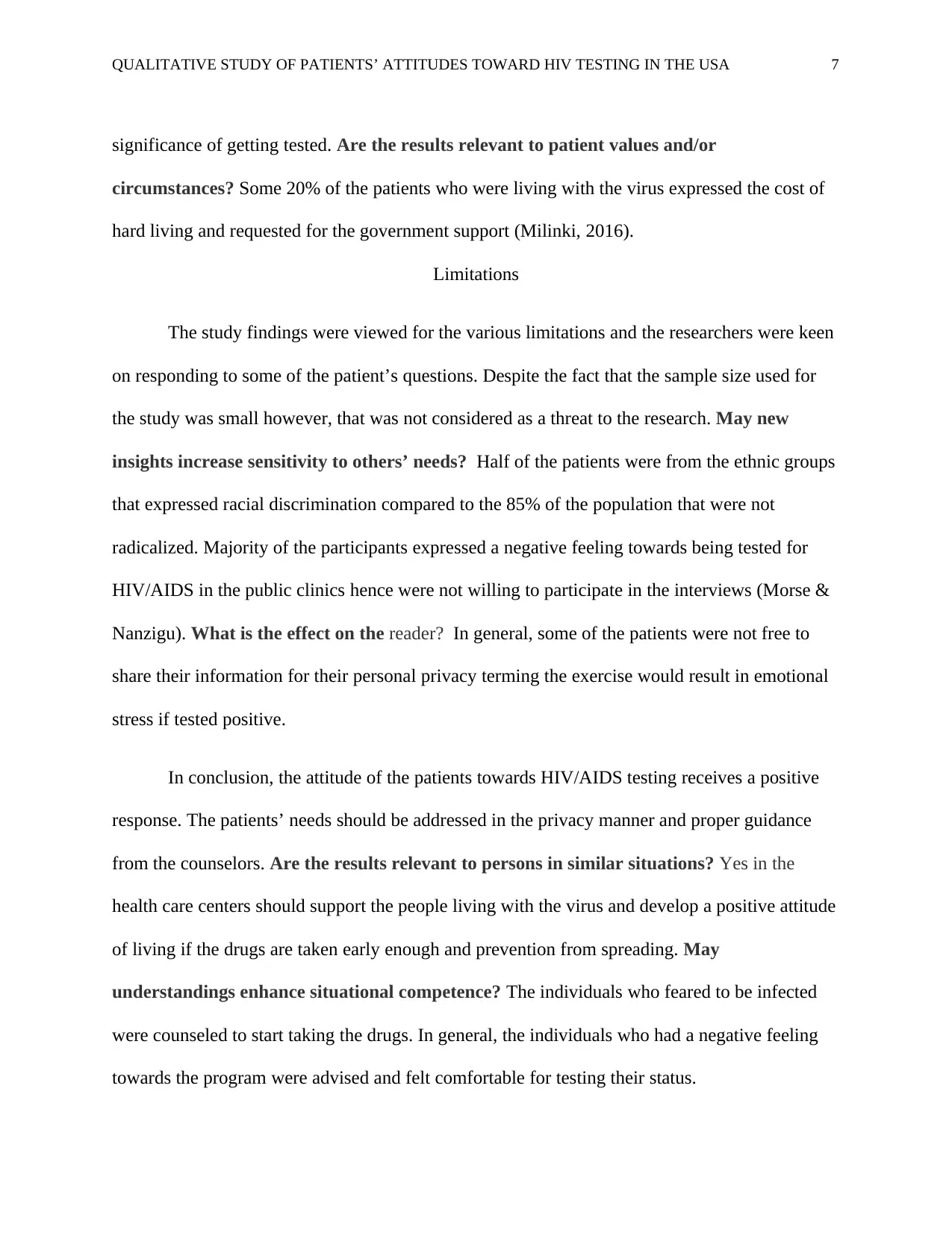
QUALITATIVE STUDY OF PATIENTS’ ATTITUDES TOWARD HIV TESTING IN THE USA 7
significance of getting tested. Are the results relevant to patient values and/or
circumstances? Some 20% of the patients who were living with the virus expressed the cost of
hard living and requested for the government support (Milinki, 2016).
Limitations
The study findings were viewed for the various limitations and the researchers were keen
on responding to some of the patient’s questions. Despite the fact that the sample size used for
the study was small however, that was not considered as a threat to the research. May new
insights increase sensitivity to others’ needs? Half of the patients were from the ethnic groups
that expressed racial discrimination compared to the 85% of the population that were not
radicalized. Majority of the participants expressed a negative feeling towards being tested for
HIV/AIDS in the public clinics hence were not willing to participate in the interviews (Morse &
Nanzigu). What is the effect on the reader? In general, some of the patients were not free to
share their information for their personal privacy terming the exercise would result in emotional
stress if tested positive.
In conclusion, the attitude of the patients towards HIV/AIDS testing receives a positive
response. The patients’ needs should be addressed in the privacy manner and proper guidance
from the counselors. Are the results relevant to persons in similar situations? Yes in the
health care centers should support the people living with the virus and develop a positive attitude
of living if the drugs are taken early enough and prevention from spreading. May
understandings enhance situational competence? The individuals who feared to be infected
were counseled to start taking the drugs. In general, the individuals who had a negative feeling
towards the program were advised and felt comfortable for testing their status.
significance of getting tested. Are the results relevant to patient values and/or
circumstances? Some 20% of the patients who were living with the virus expressed the cost of
hard living and requested for the government support (Milinki, 2016).
Limitations
The study findings were viewed for the various limitations and the researchers were keen
on responding to some of the patient’s questions. Despite the fact that the sample size used for
the study was small however, that was not considered as a threat to the research. May new
insights increase sensitivity to others’ needs? Half of the patients were from the ethnic groups
that expressed racial discrimination compared to the 85% of the population that were not
radicalized. Majority of the participants expressed a negative feeling towards being tested for
HIV/AIDS in the public clinics hence were not willing to participate in the interviews (Morse &
Nanzigu). What is the effect on the reader? In general, some of the patients were not free to
share their information for their personal privacy terming the exercise would result in emotional
stress if tested positive.
In conclusion, the attitude of the patients towards HIV/AIDS testing receives a positive
response. The patients’ needs should be addressed in the privacy manner and proper guidance
from the counselors. Are the results relevant to persons in similar situations? Yes in the
health care centers should support the people living with the virus and develop a positive attitude
of living if the drugs are taken early enough and prevention from spreading. May
understandings enhance situational competence? The individuals who feared to be infected
were counseled to start taking the drugs. In general, the individuals who had a negative feeling
towards the program were advised and felt comfortable for testing their status.
Paraphrase This Document
Need a fresh take? Get an instant paraphrase of this document with our AI Paraphraser
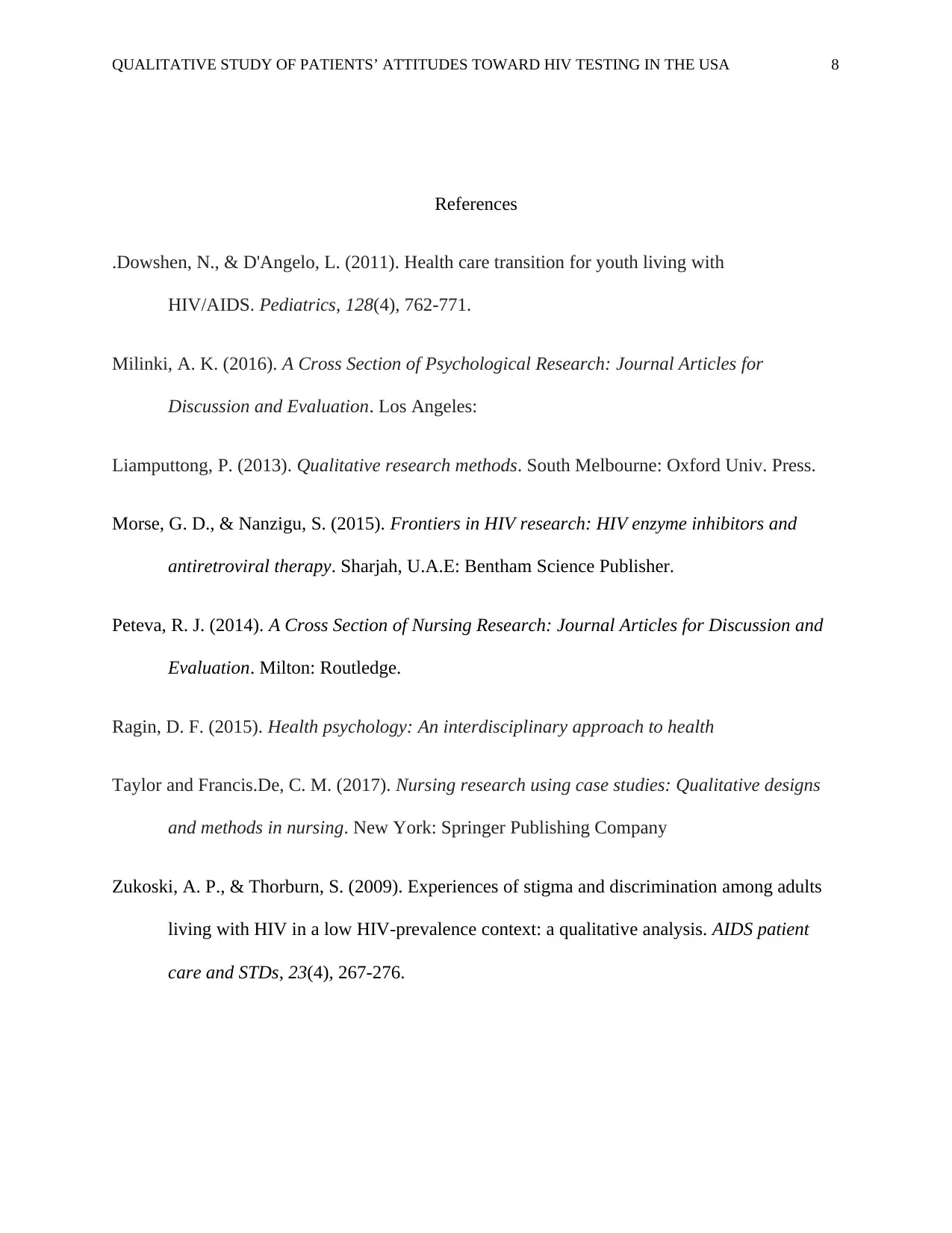
QUALITATIVE STUDY OF PATIENTS’ ATTITUDES TOWARD HIV TESTING IN THE USA 8
References
.Dowshen, N., & D'Angelo, L. (2011). Health care transition for youth living with
HIV/AIDS. Pediatrics, 128(4), 762-771.
Milinki, A. K. (2016). A Cross Section of Psychological Research: Journal Articles for
Discussion and Evaluation. Los Angeles:
Liamputtong, P. (2013). Qualitative research methods. South Melbourne: Oxford Univ. Press.
Morse, G. D., & Nanzigu, S. (2015). Frontiers in HIV research: HIV enzyme inhibitors and
antiretroviral therapy. Sharjah, U.A.E: Bentham Science Publisher.
Peteva, R. J. (2014). A Cross Section of Nursing Research: Journal Articles for Discussion and
Evaluation. Milton: Routledge.
Ragin, D. F. (2015). Health psychology: An interdisciplinary approach to health
Taylor and Francis.De, C. M. (2017). Nursing research using case studies: Qualitative designs
and methods in nursing. New York: Springer Publishing Company
Zukoski, A. P., & Thorburn, S. (2009). Experiences of stigma and discrimination among adults
living with HIV in a low HIV-prevalence context: a qualitative analysis. AIDS patient
care and STDs, 23(4), 267-276.
References
.Dowshen, N., & D'Angelo, L. (2011). Health care transition for youth living with
HIV/AIDS. Pediatrics, 128(4), 762-771.
Milinki, A. K. (2016). A Cross Section of Psychological Research: Journal Articles for
Discussion and Evaluation. Los Angeles:
Liamputtong, P. (2013). Qualitative research methods. South Melbourne: Oxford Univ. Press.
Morse, G. D., & Nanzigu, S. (2015). Frontiers in HIV research: HIV enzyme inhibitors and
antiretroviral therapy. Sharjah, U.A.E: Bentham Science Publisher.
Peteva, R. J. (2014). A Cross Section of Nursing Research: Journal Articles for Discussion and
Evaluation. Milton: Routledge.
Ragin, D. F. (2015). Health psychology: An interdisciplinary approach to health
Taylor and Francis.De, C. M. (2017). Nursing research using case studies: Qualitative designs
and methods in nursing. New York: Springer Publishing Company
Zukoski, A. P., & Thorburn, S. (2009). Experiences of stigma and discrimination among adults
living with HIV in a low HIV-prevalence context: a qualitative analysis. AIDS patient
care and STDs, 23(4), 267-276.
1 out of 8
Related Documents
Your All-in-One AI-Powered Toolkit for Academic Success.
+13062052269
info@desklib.com
Available 24*7 on WhatsApp / Email
![[object Object]](/_next/static/media/star-bottom.7253800d.svg)
Unlock your academic potential
© 2024 | Zucol Services PVT LTD | All rights reserved.





